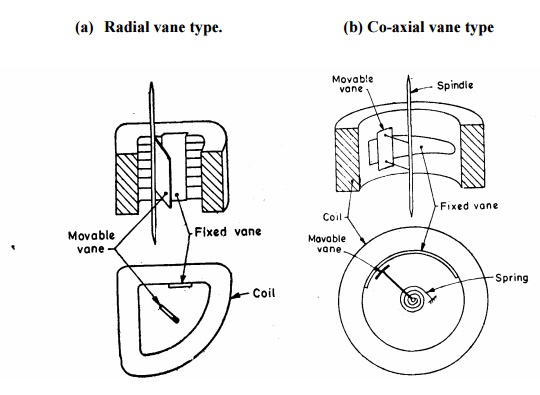Chapter: Measurements and Instrumentation : Electrical and Electronics Instruments
Moving Iron Instruments: Classification, Construction, Torque Equation, Errors, Advantages and Disadvantages

Moving Iron Instruments
Classification of Moving Iron Instruments
Moving iron instruments are of two types
(i) Attraction type.
(ii) Repulsion type.
1 . Attraction Type

Ø The coil is flat and has a narrow slot like opening.
Ø The moving iron is a flat disc or a sector eccentrically mounted.
Ø When the current flows through the coil, a magnetic field is produced and the moving iron moves from the weaker field outside the coil to the
Stronger field inside it or in other words the moving iron is attracted in.
Ø The controlling torque is provide by springs hut gravity control can be used for panel type of instruments which are vertically mounted.
Ø Damping is provided by air friction with the help of a light aluminium piston (attached to the moving system) which move in a fixed chamber closed at one end as shown in Fig. or with the help of a vane (attached to the moving system) which moves in a fixed sector shaped chamber a shown.
2. Repulsion Type
In the repulsion type, there are two vanes inside the coil one fixed and other movable. These are similarly magnetized when the current flows through the coil and there is a force of repulsion between the two vane s resulting in the movement of the moving vane. Two different designs are in common use
(I) Radial Vane Type
In this type, the vanes are radial strips of iron.
The strips are placed within the coil as shown in Fig.
The fixed vane is attached to the coil and the movable one to the spindle of the instrument.
(a) Radial vane type. (b) Co-axial vane type

(ii) Co-axial Vane Type
Ø In this type of instrument, the fixed and moving vanes are sections of co axial cylinders as shown in Fig.
Ø The controlling torque is provided by springs. Gravity control can also he used in vertically mounted instruments.
Ø The damping torque is produced by air friction as in attraction type instruments.
Ø The operating magnetic field in moving iron instruments is very weak and therefore eddy current damping is not used in them as introduction of a permanent magnet required for eddy current damping would destroy the operating magnetic field.
Ø It is clear that whatever may be the direction of the current in the coil of the instrument, the iron vanes are so magnetized that there is always a force of attraction in the attraction type and repulsion in the repulsion type of instruments.
Ø Thus moving iron instruments are unpolarised instruments i.e., they are independent of the direction in which the current passes.
Ø Therefore, these instruments can be used on both ac. and d.c.
Torque Equation of Moving Iron Instrument:
An expression for the torque moving iron instrument may be derived by consid ring the energy relati ons when there is a sm all increment in current supplied to the instrument. When this happens there will be a small deflection dș a mechanical work will be done. Let Td be the deflecting torque.
Mechanical work done = Td. d ș
Alongside there will be a change in the energy stored in the magnetic field owing to change in inductance.
Suppose the initial current is I, the instrument inductance L and the deflection ș. If the current is increased by di then the deflection changes by d ș and the inductance by dL. In order to affect a n increment the current there must be an increase in the applied voltage given by


Hence t he deflection is proportional to square of the r ms value of the operating cur rent. The deflecting torque is, therefore, unidirectional ( acts in the same direction) whatever may be the polarity of the current.
Comparison between Attraction and Repulsion Types of Instruments
In general it may be said that attraction-type instruments possess the same advantages, and are subject to the limitations, described for the repulsion type.
An attraction type instrument will usually have a lower inductance than the corresponding repulsion type instrument, and voltmeters will therefore be accurate over a wider range of frequency and there is a greater possibility of using shunts with ammeters.
On the other hand, repulsion instruments are more suitable for economical production in manufacture, and a nearly uniform scale is more easily obtained; they are, therefore, much more common than the attraction type.
Errors in Moving Iron Instruments
There are two types of errors which occur in moving iron instruments — errors which occur with both a.c. and d.c. and the other which occur only with ac. only.
Errors with both D.C. and A.C
i) Hysteresis Error
ii) Temperature error
iii) Stray magnetic field
Errors with only A.C
Frequency errors
Advantages & Disadvantages
1) Universal use
(2) Less Friction Errors
(3) Cheapness
(4) Robustness
(5) Accuracy
(6) Scale
(7) Errors
(8) Waveform errors.
Related Topics